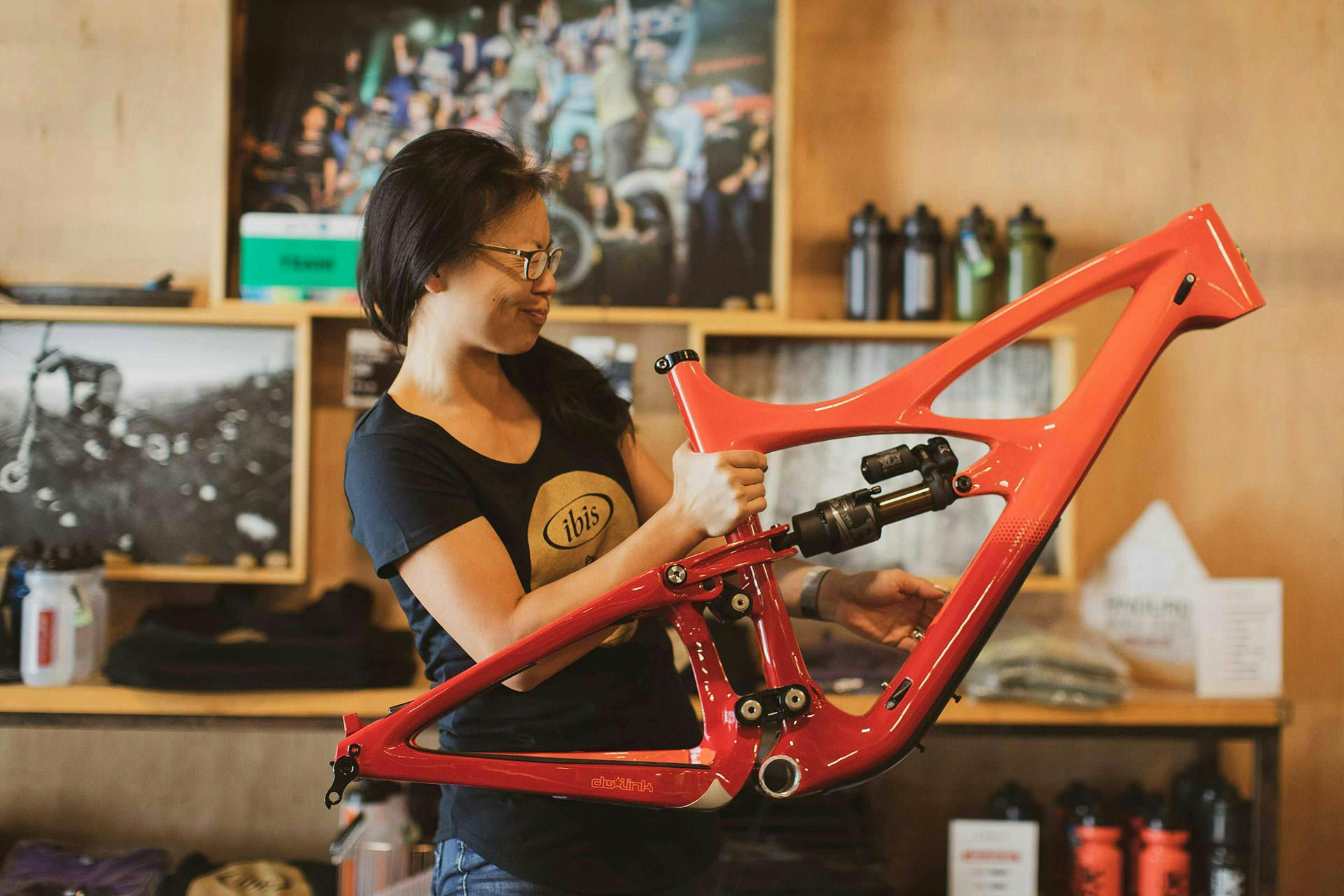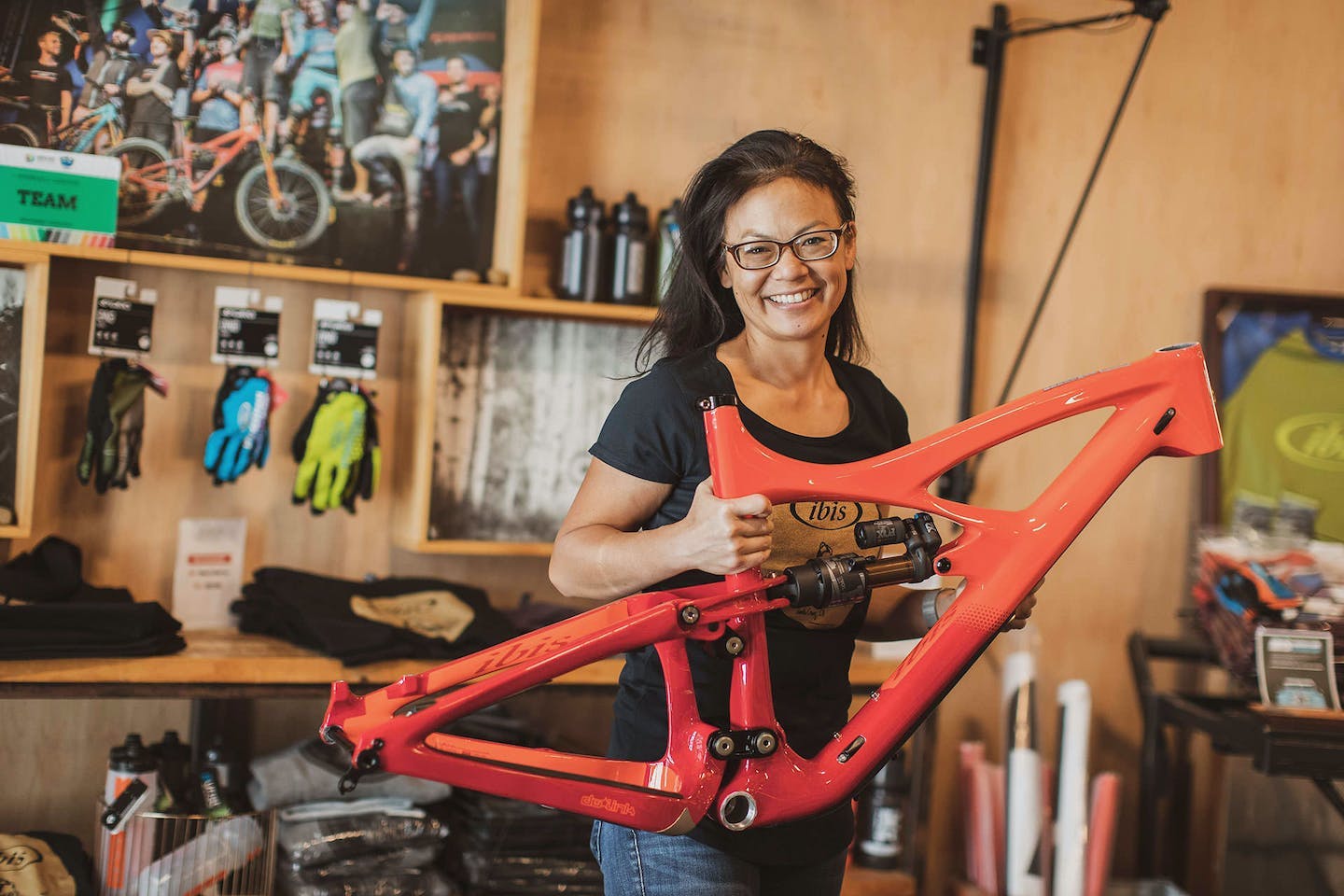Design, Innovation & Inspiration With Roxy Lo of Ibis Cycles
Words: Pete Harrington
Photos: Saris Mercanti
Roxy Lo is running late. “Sorry!” she chirps, smiling warmly and waving like my train is departing as we finally connect, “my watch tried to answer the phone and it totally spaced out on me.”
If not for the screens between us, it feels like the woman credited with reinvigorating Ibis Cycles could jump the distance from her Santa Cruz office to Squamish with a moment’s notice. She has what you might call, pep. But instinctual problem solving is never too far off the radar for this industrial designer turned bike geek, which is why she’s still mulling over the failure of her watch to catch our call as we settle down for a Skype-shared coffee to chat design, inspiration, and finding a bike small enough to fit her 5ft 1” form.
The story of how Roxy came to work at Ibis has been told elsewhere, but turning a straight-up business card design commission into a career sketching out some of the most well-reviewed, trend-setting bikes in the industry, with no prior two-wheel experience, still raises eyebrows to this day. “You know, there are a lot of times when people take a chance on someone creative, without knowing exactly where their skill set is,” she says. “And getting to know someone through working is kind of a great way to do an interview.”
When Roxy was asked to join Ibis and design the brand’s groundbreaking carbon monocoque Mojo, it was, she suspects, a lot to do with the search for that creative spark. “When you’re surrounded by your peers in the industry, coming up with a standout bike design is incredibly hard,” she explains. “So when the guys met me, even though I was outside looking in, they recognised something in my portfolio and my creativity. I suspect they trusted that in the right environment, fresh ideas would beat out the need for experience.”

Founded in 1981 by Scot Nicol, one of northern California’s earliest mountain bikers, Ibis developed a reputation for making innovative titanium road and mountain bikes. Sadly, the brand filed for bankruptcy in 2001, only 20 months after Scot had sold it to an investment group. In 2004, returning to the company he first started, Scot partnered with fellow industry lifers Tom Morgan and Hans Heim, who saw Ibis as the perfect vehicle for realising their dream of evolving the mountain bike. All they needed was a designer.
“I joined after Hans Heim first envisioned the bike,” Roxy recalls. “And his thought was, ‘Hey, let’s build a bike that’s completely different and coming out of left field to relaunch the entire brand.’” Noticing the trend towards carbon bikes in the road space, Ibis felt that the mountain bike market was ready for a complete carbon monocoque design; an idea Hans and the team hoped would capture the imagination of their customers and the attention of the press. “At that time, there hadn’t been a full carbon mountain bike yet. And of course, carbon was already prolific in the road biking industry,” she says. “I think Specialized had a mountain bike with a carbon front and an aluminum rear triangle. But, other than hand-built stuff, I think we were the first to bring a full carbon monocoque to the market.”
Working alongside suspension-guru Dave Weagle (he of the legendary DW-link system), Roxy was tasked with connecting the lines and making what would become the Mojo, look cohesive. But before breaking out the pencils, first came an existential question. “With carbon, you can pretty much make any shape. As an artist, you’re kind of like, ‘Oh, it could look like this, and that would be cool.’ But, if you look at something and say, ‘Okay, what’s the icon in my brain that I think of when I see the word bicycle?’, then you realise that your job is to maintain the association with that well-established archetype,” she explains. “What we expect a bicycle to look like is seared into the brain.”
Ask what her hopes were for the Mojo’s design, and she’ll talk to you about the importance of aesthetics, perception, feelings and freedom – an industrial designer’s playbook. “When I was asked to design the bike, I wanted it to speak to the rider, to communicate that this is going to take you on a journey, that it’s going to do everything it looks like it can do,” she enthuses. “And so I hoped that the design would inspire people to look at it and to take it out; that it would not just be a tool.”

The rest, of course, is recent history. The Mojo set the mountain bike industry on a carbon trajectory, which Ibis, with the recent release of the Ripmo 29-er, is still navigating. “Looking back, most people saw it as a bold move,” she says. “They were on board and so happy to be a part of the new world of carbon. I think some customers didn’t understand it – people who preferred the welded, handmade approach – some of those customers did come back to us. But some people were just like, ‘No, I don’t know this company anymore,’ which considering how cutting edge carbon was in 2005, and how different we were to the old Ibis, is an attitude I can understand.”
In the years that followed the launch of the Mojo, Ibis could easily have followed the rest of the bike industry down the rabbit hole of regular as clockwork product cycles. And while there are often good reasons for retiring a product, frequently, new models are pushed through for no other reason than to seek attention – the digital equivalent of a desperate two-hand wave from a rip-caught surfer. Roxy though, ever the outsider, never subscribed to that mindset. “Sometimes we’ll do a different colorway or something, but we don’t have model years because we just have models,” she explains, offering the super light special edition Mojo as an example. “For the SL, we pared down all the extraneous carbon that we could, creating a wholly new machine. You couldn’t say, ‘That’s just a model in year 2010 versus a ’12.’ You know? It’s an entirely different bike.”
As mountain biking is buffeted by trends that threaten to become fixtures, Roxy nevertheless feels that today, innovation is driven forward by new types of riding as much as from in-house R&D. “For the longest time you had the downhillers and the cross-country people, and those two didn’t blend. But with enduro, it does. It’s interesting how that format of racing has changed how we build bikes. Sometimes it’s rocky, or wet. You’re riding the bikes up and down the mountain, so you can’t just make a burly bike that only goes in one direction. You also have to think about hydration, which means making room for things like water bottles. And, you have to have impressive geometry so that you have good climbing power.”
Asked if she enjoys the challenge of designing an ‘everything mountain bike’, she says, “Oh man, so happy. There are steep things that could make your hair stand on end – it’s like controlled falling!”

But for all her success, Roxy did have some problems fitting into the bike world, although not the ones you might expect. “Haha, yeah well, I’m only 5’1”, so I literally could not find a bike to fit!” she says, laughing easily. “When I was in college, I remember it being hard for me to find a motorcycle for my size – one that didn’t look like a low rider with monkey handlebars above my head. When I came to Ibis, I wanted to make sure that people who weren’t normally able to access our products could access them,” she explains. “Of course, that means making sure smaller riders can find an Ibis to fit them, but also from an inclusive mindset, it means being open to everybody.”
After 13 years at Ibis, Roxy is now as much industry veteran as industrial designer: Is she in danger of becoming the very thing that she first replaced? “Thankfully, I have other interests outside of biking,” she says. “I love looking at architecture and different types of design in all different ways. Even interior design, how colors and materials go together. I also enjoy antiquing and going to vintage stores. There are so many products that are still relevant and useful to this day.”
And of course, design always reflects the current national mood. “I feel like if you keep your eye open, you can feel the pulse of what’s going on with everybody,” she says. “Right now, things are fraught, and everyone’s trying to lighten the mood or get brighter or do whatever. Sometimes it’s very somber, and it’s like, ‘Okay, we’re going to get into the details of the color and finish and things like that.’ How far away or close to it do you want to be? The bike is the way for us to escape a lot of stuff. It’s not rocket science, it’s not saving the world, but it is saving people’s sanity. Every ride you take, it’s like one step happier, you know?”
